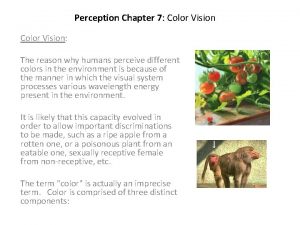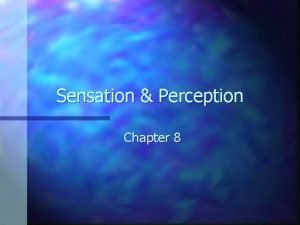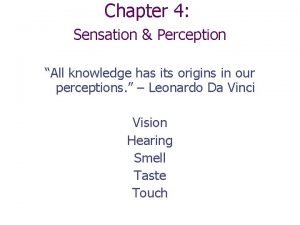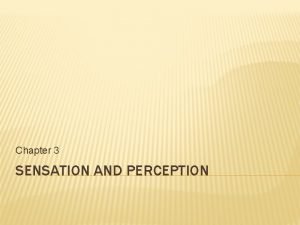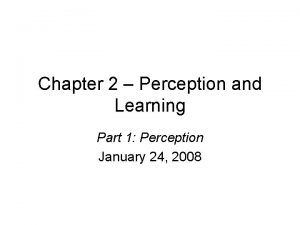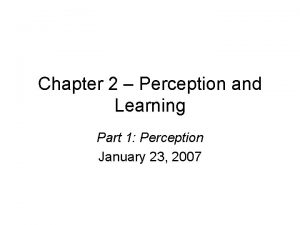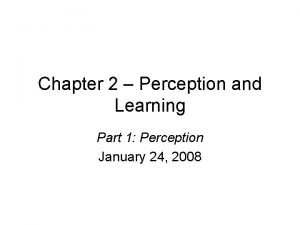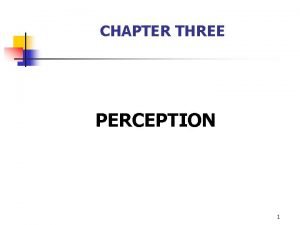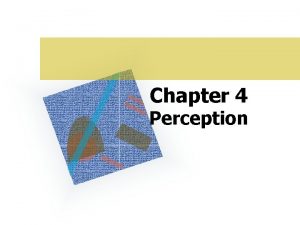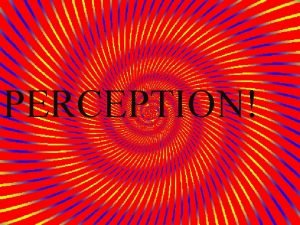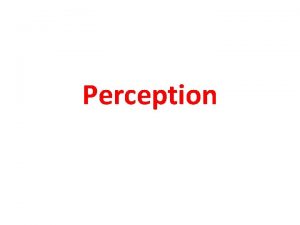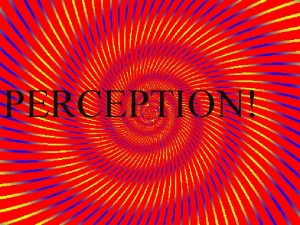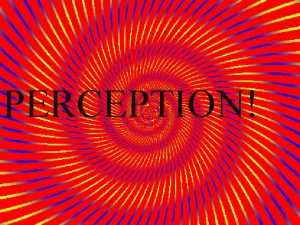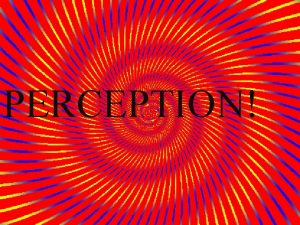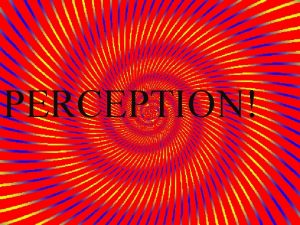Chapter 2 Perception and Learning Part 1 Perception













- Slides: 13

Chapter 2 – Perception and Learning Part 1: Perception January 27, 2009

Perception • Combining, integrating, & interpreting info – 3 stages • 1. Selection – influenced by internal & external factors. – Internal – implications? – External – implications? – What is figural (salient) versus background (filler)?

Perception (stages cont…) • 2. Organization – Use schemas to make sense and infer relationships among targets • Correspondent inferences - – Schemas differ between people – …leading to incorrect inferences • Focus on ‘weak’ situations for more information?

• 3. Evaluation – Interpret events in subjective fashion – influenced by biases – Can be barrier to cross-cultural communication – Adler’s sources of cultural misinterpretation • What are these? • Subconscious cultural blinders – • Projected similarity –

Attribution Process - Kelley • Attribute actions to internal (trait) or external (situation) causes • Consensus –defined as… • Consistency – defined as… • Distinctiveness – defined as…

Attribution • Why is your friend complaining about her manager? • Assume high consensus & distinctiveness, but low consistency – which attribution is predominant? • Assume low consensus & distinctiveness, but high consistency – which attribution?

Attribution errors • Self-serving bias – What is the bias? – Generalizability to other cultures? • Fundamental Attribution Error (FAE) – Opposite of self-serving (judging others) – What is the error? – Linked to perf appraisals • Halo effect – • (** See book for similar-to-me, selective perception, Pygmalion & Golem effects, performance appraisals and selection applications**)

Perceptions of Performance Appraisals • De. Nisi & Gonzalez (2004) – propose importance of ratee’s perceptions of the appraisal: • How would each of these help? – 1. importance of clear standards – – 2. simple-to-use rating instruments – • Example of performance diaries or incident logs

Stereotyping • Dangers of relying on stereotype of group to categorize a person from that group • Reasons stereotypes can become problematic? – 1) – 2) – 3) • Stereotype threat – fear being evaluated by stereotype lowers performance – Examples?

Johari Window • One way to minimize biases by making people aware of their values, prejudices • Divides info about you into 4 ‘windows’ based on whether your values/beliefs are known to you & others – Open, blind, hidden, unknown areas – What is the goal?

Johari Window Feedback Known Unknown to self Disclosure Known to others Open area Blind area Unknown to others Hidden Unknown area

Johari Window (cont. ) • Can work w/360 degree feedback program • Problems: – 1) – 2) – 3)

Dual Attitude System • Wilson proposed we have implicit (subconscious) attitudes & explicit (stated) attitudes – Implicit – – Explicit – – See www. understandingprejudice. org/iat/ – How does it measure each type of attitude?
 Cuadro comparativo e-learning m-learning b-learning
Cuadro comparativo e-learning m-learning b-learning Chapter 5 sensation and perception
Chapter 5 sensation and perception Color vision
Color vision Chapter 3 sensation and perception
Chapter 3 sensation and perception Chapter 6 sensation and perception
Chapter 6 sensation and perception Psychology chapter 4 sensation and perception
Psychology chapter 4 sensation and perception Kinesthetic sense
Kinesthetic sense Chapter 8 sensation and perception
Chapter 8 sensation and perception Chapter 7 managing risk vision and perception
Chapter 7 managing risk vision and perception Chapter 4 sensation and perception
Chapter 4 sensation and perception Chapter 3 sensation and perception
Chapter 3 sensation and perception Part part whole addition
Part part whole addition Part to part ratio definition
Part to part ratio definition Part part whole
Part part whole


